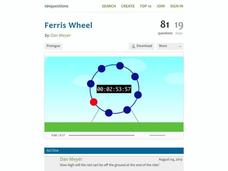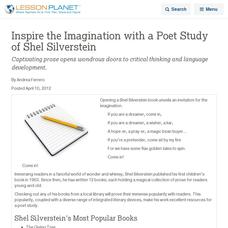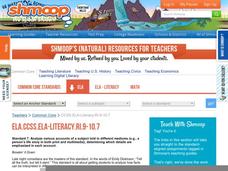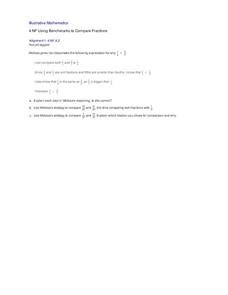NASA
Exploring Data
Bring the sun to your class! Young scholars analyze actual solar wind data in the second lesson of a five-part series. Their analysis includes speed, temperature, and density data.
101 Questions
Ferris Wheel
Around and around you'll go! Learners analyze the periodic nature of a Ferris wheel. Using a trigonometric function, they make predictions about the location of a specific car at the end of the ride and its total trips around the circle.
Houghton Mifflin Harcourt
Give It All You’ve Got!: English Language Development Lessons (Theme 2)
Go beyond the textbook to gain a better appreciation for the English language. A series of ESL lessons help expand the concepts found in Theme 2: Give It All You've Got. The second lesson in a three-part unit incorporates strategies such...
101 Questions
Pokémon Go Cheat
Gotta catch them all—no learner left behind! Young scholars must predict the length of time it takes a phone attached to a fan to travel five kilometers given the radius and rotations versus time data. Why would you attach a phone to a...
Biology Junction
Protists: The World of Protists
More than 200,000 species of protists exist, living on land and in water around the planet. Scholars view the diversity of protists in an interesting presentation. It divides protists into three groups: animal-like protists, plant-like...
DiscoverE
Design a Wind Turbine
Discover the power of wind energy. Learners design, build, and test wind blades in a hands-on experiment. They analyze the results to determine if they can make any improvements before gathering as a class to discuss their designs.
American Museum of Natural History
Train of Thought
Hop aboard the train of thought. A remote learning resource has learners consider thought experiments to consider scientific theories. It provides two examples, one on orbiting bodies and the other on the speed of light, for them to work...
American Museum of Natural History
One-on-One With The Sun
Follow along as Stella Stardust interviews the sun. A fun and informative interview provides scholars with information about the sun.
American Museum of Natural History
Make Your Own Weather Station
Scholars build a weather station equipped with a wind vane, rain gauge, and barometer. Following an informative page about the weather, learners follow steps to build their pieces then turn into meteorologists to chart the weather they...
Curated OER
What Causes Day and Night?
Why do we have four seasons? A series of questions about the Earth's orbit and its impact on seasons challenge Earth science students.The second page of the resource has nine multiple choice questions, such as "One year on Earth is one...
Curated OER
May the Force be with You -- All about Force and Gravity
Here is a fabulous set of teacher's notes that will make your next hands-on gravity and force lab fun and interesting. These notes provide you with three activities that allow children to make and test hypothesis regarding force,...
Curated OER
Verbs
For this math worksheet, students color in the verbs that each given noun can do. Students also choose a verb that describes each picture.
Curated OER
Reasons for the Seasons
This worksheet requires the pupils to follow a teacher activity, so more-than-the-usual preparation for a practical is needed. Looking at a globe as it rotates and receives "sunlight" from a flashlight, pupils are able to observe the...
Curated OER
Inspire the Imagination with a Poet Study of Shel Silverstein
Captivating prose opens wondrous doors to critical thinking and language development.
Curated OER
Playing Pinata at a Party
What is a Pinata and why is every body hitting it with a stick? Prepare your Autistic child for a common birthday activity that may be slightly over-stimulating. This printable book explains what a pinata is and how it is used at a...
K12 Reader
Extreme Weather
Thunderstorms, tornados, blizzards, hurricanes. These extreme forms of weather are the focus of an article on a two-part reading comprehension worksheet. After reading the passage, kids use information in the text to respond to a series...
Curated OER
The Four Revolutions of the 18th Century: Industrial, Demographic, Agricultural, and French
In need of lecture notes that will help you and your learners? Here you'll find a presentation that covers four major revolutions occurring in the 1800's; The French Revolution, The Industrial Revolution, the agricultural revolution, and...
K12 Reader
Metaphors Compare Things
This learning exercise on metaphors is your ticket to better writing! As learners read ten sentences, they underline the metaphor and circle the two objects of comparison.
Curated OER
Reading Comprehension 5: level 11
Use this reading comprehension exercise at the beginning of the year to assess the reading comprehension level of your class, to remind readers of how to use strategies to decode dense text, or to assess the skills of a new student....
Curated OER
Alleys (Tennis)
"Alleys" is a drill or game-like situation to practice what has already been taught in previous lessons. The tennis court is divided in half, left side and right side, so that each pair of players has an alley. The goal is to aim for the...
Starry Night Education
The Year and Seasons
Turn your classroom into a live demonstration of how the earth and sun interact to create the four seasons. Using a globe, a light source, and a series of constellation cards, super scientists discover how the...
Shmoop
ELA.CCSS.ELA-Literacy.RI.9-10.7
When your pupils read an account of an event, are they conscious of the fact that this particular account might focus on certain details, while ignoring others? Open their eyes to bias and varying interpretation of facts with the...
Tiny Mobile
Poetry Creator | Verses
Construct from a canvas of words, lyrical expressions that your budding poets can share and post. Based on refrigerator magnet poetry, creative writers can develop their poetry independently, or from a given prompt from their...
Illustrative Mathematics
Using Benchmarks to Compare Fractions
Introduce a new strategy for comparing fractions by analyzing Melissa's use of benchmarks. Walk the class through her process, calling on students to explain their understanding of each step she took. Then practice this method on two...
Other popular searches
- Spinning Color Wheel
- Spinning Tops
- Spinning Jenny
- Spinning Myths
- Spinning Wool
- Bill Nye Spinning Things
- Spinning Top Activities
- Bill Nye "Spinning Things"
- Spinning Tops Toys
- Spinning in Space
- Spinning Aerobics
- Spider Web Spinning























